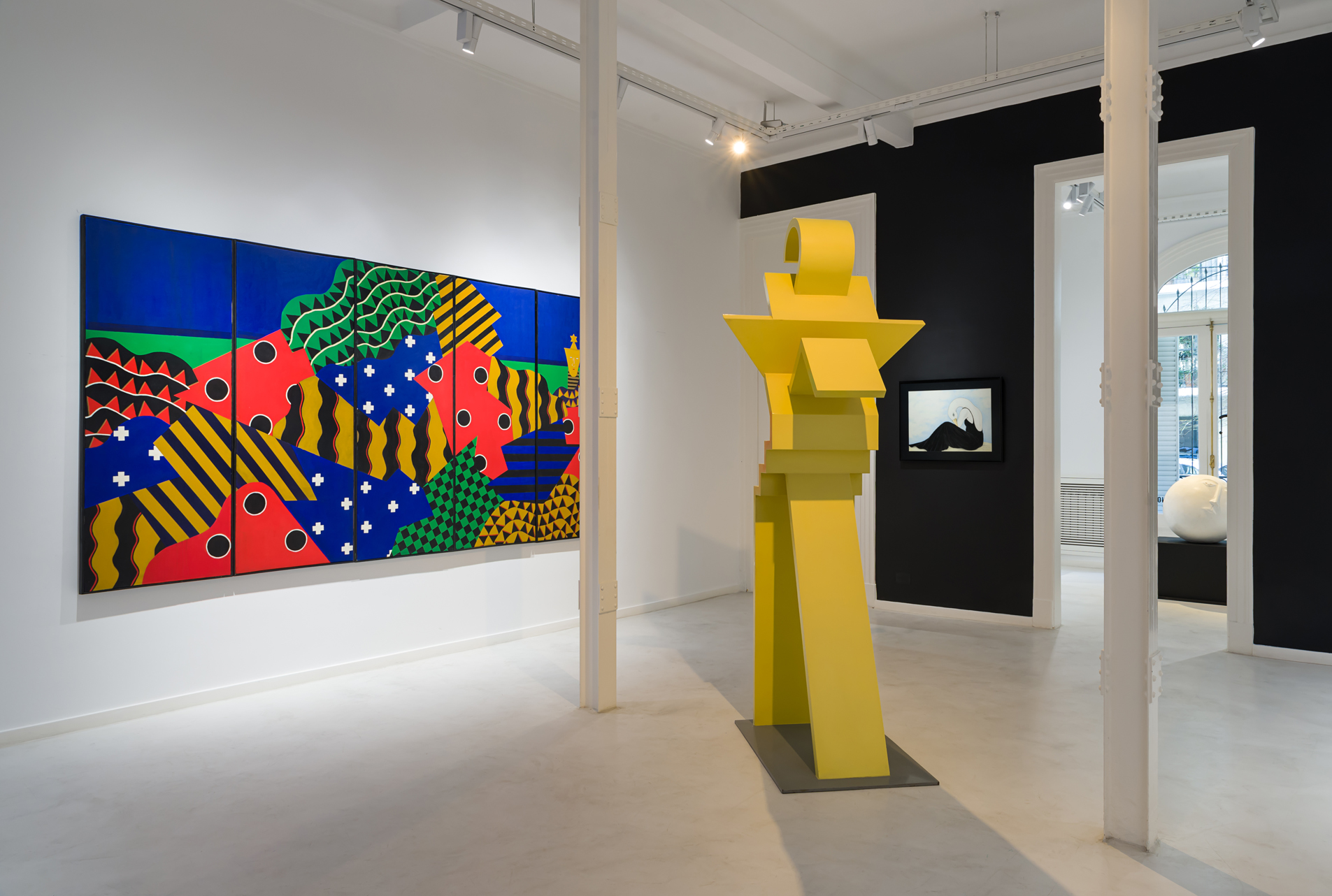Playing is also a serious matter!
In 1984, Manuel Espinosa participated in the exhibition El juguete (The Toy), a group show that brought together well-known artists to create toys. For this, Espinosa created Juego de la Matusa, a stacking game made of yellow, blue, red, and green acrylic pieces. Ingeniously and sensitively, he used geometric rationality to create a visual construction device that invites the viewer to engage in an open formal experiment.
The relationship between art and play has numerous precedents throughout the history of art, with many artists linking play to artistic practices to foster creativity or stimulate the imagination. From the toys created by Joaquín Torres García and the esoteric game invented by Xul Solar to the central role of participatory experiences in the playful environments of the 1960s, Playing is also a serious matter! proposes a playful approach to art. It is an exhibition composed of a selection of works that center their investigations around play and playful exploration: from participatory proposals that directly engage the viewer’s experience, toys as objects produced by renowned artists, and a body of works that refer to the imaginary of childhood.
Hans-Georg Gadamer presents play as an elemental function of human life, to the point where one could not think of human culture without a playful component. Through play, we learn to share, experience, create, solve problems, and connect with others. Some of the essential aspects of play, as pointed out by Gadamer, include playing-with, a repeating movement, and a particular inclusion of reason, where everything is ordered as if it had a purpose. However, play turns out to be a free rationality with no other aim beyond the play itself.[1]
In a similar way to Juego de la Matusa, Rogelio Polesello’s acrylics propose a playful activity focused on participation and playing-with the visitors, the surrounding space, and the works displayed here. The concave and convex forms of his carved pieces alter perception through the movement or change in the viewer’s angle of vision, generating an optical game of transformation. Polesello makes us move back and forth, repeating a motion that resolves itself in the play space. On the other hand, Ernesto Ballesteros uses constant, repeated movement, slightly choreographed, to create his drawings from play and the participation of others. As if having a purpose, Ballesteros organizes the movement with which he constructs these enormous tangles of pink and yellow threads, with no other goal than the freedom of creative experimentation. His drawings highlight the value of play as a tool for creation and reflection.
The universe of toys also emerged in the production of Luis F. Benedit, a renowned conceptual artist who focused on exploring the connections between art and science. Through the childlike drawings of Tomás, his five-year-old son, Benedit approached the world of toys. In this series of works, the artist included his son’s drawings – from a policeman to the bride of King Kong – and his own reinterpretation of the drawings as a projective design, which he then brought into three-dimensional objects.
Some toys are created from their own universe, while others are built from shared fantasies. Many games and toys belong to specific eras, marking generational milestones, while others remain relevant over time. In Giménez, an artist who navigated various genres – painting, sculpture, architecture, graphic design – marked by joy and pop beauty, we find a universe of fantasy and childhood imagination in his work. Clouds, monkeys, cats, rabbits, among others, are recurring elements in his art, as well as the green labyrinths included in this exhibition. Like the labyrinthine gardens of European palaces, Giménez constructed green geometric walls, streets, and crossroads that invite his characters to play at getting lost and finding the way out.
In Pop Folklórico, Cynthia Cohen gathers various objects on a small altar: from a book of Frida Kahlo next to one of Barbie, a Hawaiian doll with her arms wide open, to a small toy horse. All these memories are stacked between stars and bright bows tied with light blue ribbon against a pink background. In this small altar, elements of cultural consumption, souvenirs, and childhood toys coexist on the same level, configuring the artist’s universe.
Dino Bruzzone, on the other hand, explores and dives into the imagination of other generations and childhoods. His most recent work consists of large paintings with bright flat colors, crossed by the offset dot pattern, representing images from a comic strip from the early 20th century. Krazy Kat is a strip created by George Herriman that was published in American newspapers from 1913 to 1944, blending innocence, surrealism, and a certain romanticism in its images and plot. The strip centers on the adventures of Krazy Kat, who is in love with the mouse Ignatz, but his love is unrequited.
Finally, Fernando Brizuela also takes childhood dolls like Hulk and King Kong to create a true bestiary. These dolls – sold in toy stores for children and personifying strength and power – transform in Brizuela’s hands into monsters, creatures with sharp teeth, crazed eyes, and uncontrollable strength in their hands. This aggressive gesturality is covered with marijuana, creating a strange transfiguration of the characters between the human, animal, and vegetal. With irony, these monsters seem to expose a prejudice, a fear possibly constructed from misinformation and arbitrariness. Also part of his production are botanical watercolors that recall the records of 19th-century traveling painters made during expeditions.
The universe of play, toys, and fantasies are important matters, not only because they present themselves as a possible antidote to the rigidity of routine and daily life, but also due to their transformative relevance for our experience in the world.
Ayleén Vázquez
[1] Hans-Georg, The Relevance of the Beautiful. Art as Play, Symbol, and Festival. Barcelona: Paidós, 2002.
Selected Artists: Manuel Espinosa, Rogelio Polesello, Edgardo Giménez, Luis F. Benedit, Ernesto Ballesteros, Cynthia Cohen, Fernando Brizula, and Dino Bruzzone
Curatorship: Agustina Espinosa, Bárbara Espinosa, and Ayelén Vázquez.

